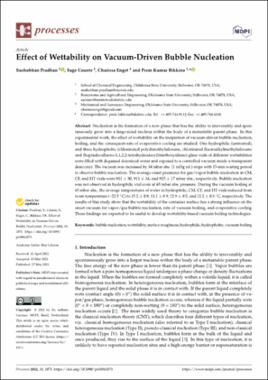| dc.contributor.author | Pradhan, Sushobhan | |
| dc.contributor.author | Counts, Sage | |
| dc.contributor.author | Enget, Charissa | |
| dc.contributor.author | Bikkina, Prem Kumar | |
| dc.date.accessioned | 2022-05-31T12:50:36Z | |
| dc.date.available | 2022-05-31T12:50:36Z | |
| dc.date.issued | 2022-05-27 | |
| dc.identifier | oksd_pradhan_effectofwettability_2022 | |
| dc.identifier.citation | Pradhan, S., Counts, S., Enget, C., & Bikkina, P. K. (2022). Effect of wettability on vacuum-driven bubble nucleation. Processes, 10(6), pp. 1073-1073. https://doi.org/10.3390/pr10061073 | |
| dc.identifier.uri | https://hdl.handle.net/11244/335844 | |
| dc.description.abstract | Nucleation is the formation of a new phase that has the ability to irreversibly and spontaneously grow into a large-sized nucleus within the body of a metastable parent phase. In this experimental work, the effect of wettability on the incipiation of vacuum-driven bubble nucleation, boiling, and the consequent rate of evaporative cooling are studied. One hydrophilic (untreated), and three hydrophobic (chlorinated polydimethylsiloxane, chlorinated fluoroalkylmethylsiloxane and (heptadecafluoro-1,1,2,2-tetrahydrodecyl)triethoxysilane) glass vials of different wettabilities were filled with degassed deionized water and exposed to a controlled vacuum inside a transparent desiccator. The vacuum was increased by 34 mbar abs. (1 inHg rel.) steps with 15-min waiting period to observe bubble nucleation. The average onset pressures for gas/vapor bubble nucleation in CM, CF, and HT vials were 911 +/- 30, 911 +/- 34, and 925 +/- 17 mbar abs., respectively. Bubble nucleation was not observed in hydrophilic vial even at 65 mbar abs. pressure. During the vacuum boiling at 65 mbar abs., the average temperatures of water in hydrophilic, CM, CF, and HT vials reduced from room temperature (~22.5 degrees C) to 15.2 +/- 0.9, 13.1 +/- 0.9, 12.9 +/- 0.5, and 11.2 +/- 0.3 degrees C, respectively. The results of this study show that the wettability of the container surface has a strong influence on the onset vacuum for vapor/gas bubble nucleation, rate of vacuum boiling, and evaporative cooling. These findings are expected to be useful to develop wettability-based vacuum boiling technologies. | |
| dc.format | application/pdf | |
| dc.language | en_US | |
| dc.publisher | MDPI AG | |
| dc.relation.ispartof | Processes, 10 (6) | |
| dc.rights | This material has been previously published. In the Oklahoma State University Library's institutional repository this version is made available through the open access principles and the terms of agreement/consent between the author(s) and the publisher. The permission policy on the use, reproduction or distribution of the material falls under fair use for educational, scholarship, and research purposes. Contact Digital Resources and Discovery Services at lib-dls@okstate.edu or 405-744-9161 for further information. | |
| dc.subject | 0904 Chemical Engineering | |
| dc.title | Effect of wettability on vacuum-driven bubble nucleation | |
| dc.date.updated | 2022-05-31T06:34:24Z | |
| osu.filename | oksd_pradhan_effectofwettability_2022.pdf | |
| dc.description.peerreview | Peer reviewed | |
| dc.identifier.doi | 10.3390/pr10061073 | |
| dc.description.department | Chemical Engineering | |
| dc.description.department | Biosystems and Agricultural Engineering | |
| dc.description.department | Mechanical and Aerospace Engineering | |
| dc.type.genre | Article | |
| dc.type.material | Text | |
| dc.subject.keywords | bubble nucleation | |
| dc.subject.keywords | wettability | |
| dc.subject.keywords | surface roughness | |
| dc.subject.keywords | hydrophilic | |
| dc.subject.keywords | hydrophobic | |
| dc.subject.keywords | vacuum boiling | |
| dc.rights.license | https://creativecommons.org/licenses/by/4.0/ | |
| dc.identifier.author | ORCID: 0000-0002-6489-0159 (Pradhan, Sushobhan) | |
| dc.identifier.author | ScopusID: 57193777443 (Pradhan, Sushobhan) | |
| dc.identifier.author | ORCID: 0000-0003-1236-8032 (Bikkina, Prem Kumar) | |
| dc.identifier.author | ScopusID: 37110507300 (Bikkina, Prem Kumar) | |
